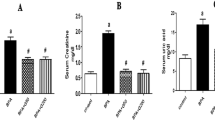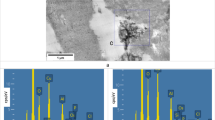Abstract
WHEN mammals are exposed to lead, the metal is incorporated into various tissues and also excreted in urine and bile. Lead is considered to pass into urine not only by glomerular filtration but also by direct transport through the tubular epithelial cells1. Histologically, tubular epithelial cells of lead poisoned kidney have been reported to have nuclear2 and extranuclear inclusions or concretions3,4, which are thought to contain lead. Biochemical examination of the kidney after administration of lead revealed that a considerable amount of lead was bound to mitochondrial and microsomal fractions5. Thus, the tubular epithelial cells of the kidney are understood not only to excrete lead into urine but also to deposit some to form inclusion bodies. The transportation of incorporated lead and the process of the formation of the inclusion body in the epithelial cells have, however, not yet been demonstrated.
This is a preview of subscription content, access via your institution
Access options
Subscribe to this journal
Receive 51 print issues and online access
$199.00 per year
only $3.90 per issue
Buy this article
- Purchase on Springer Link
- Instant access to full article PDF
Prices may be subject to local taxes which are calculated during checkout
Similar content being viewed by others
References
Vostál, J., and Heller, J., Environ. Res., 2, 1 (1968).
Goyer, R. A., May, P., Gates, M. M., and Krigman, M. R., Lab. Invest., 22 245 (1970).
Murakami, M., Jap. J. industr. Hlth, 13, 433 (1971).
Murakami, M., Ind. Health, 9, 194 (1971).
Barltrop, D., Barrett, A. J., and Dingle, J. T., J. lab. Clin. Med., 77, 705 (1971).
Castellino, N., and Aloj, S., Brit. J industr. Med., 26, 139 (1969).
Goyer, R. A., Krall, A., and Kimball, J. P., Lab. Invest., 19, 78 (1968).
Choie, D. D., and Richter, G. W., Science, N. Y., 177, 1194 (1972).
Author information
Authors and Affiliations
Rights and permissions
About this article
Cite this article
MURAKAMI, M., HIROSAWA, K. Electron Microscope Autoradiography of Kidney after Administration of 210Pb in Mice. Nature 245, 153–154 (1973). https://doi.org/10.1038/245153a0
Received:
Issue Date:
DOI: https://doi.org/10.1038/245153a0
This article is cited by
-
Cytophotometric investigations on a chronic tubular nephropathy simulating preneoplastic condition
International Urology and Nephrology (1989)
Comments
By submitting a comment you agree to abide by our Terms and Community Guidelines. If you find something abusive or that does not comply with our terms or guidelines please flag it as inappropriate.



